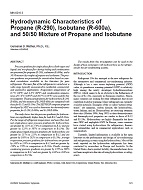Description
Pressure gradients for single-phase flows (both vapor and liquid) and two-phase flow during boiling and condensation are presented for propane (R-290), isobutane (R-600a), and a 50/50 mixture (by weight) of propane and isobutane. The pressure gradients are presented for smooth tubes based on stan-dard correlations available in the literature for pure refrigerants. The mass flux of the refrigerant is varied over a wide range typically encountered in residential, commercial, and automotive applications. Evaporation temperatures of 6.7°C (20°F) and 4.4°C (40°F) and condensation temperatures of 37.8°C (100°F) and 48.9°C (120°F) were used for this investigation. The pressure gradients for hydrocarbons R-290, R-600a, and the mixture of R-290/R-600a are compared with those for R-12 and R-134a. The REFPROP computer program developed by NIST was used to determine the thermodynamic properties for R-290, R-600a, and R-290/R-600a. The study shows that the pressure gradients for hydrocarbons are significantly higher than for both R-12 and R-134a. For the range of refrigerant temperatures and mass flux studied, single-phase vapor pressure gradients for hydrocarbons are greater by 153% to 374% in comparison to R-12 and are greater by 123% to 307% in comparison to R-134a. The single-phase liquid pressure gradients for hydrocarbons are greater by 217% to 223% in comparison to R-12 and are greater by 198% to 202% in comparison to R-134a. Average evaporation pressure gradients for hydrocarbons are greater by 168% to 339% in comparison to R-12 and are greater by 138% to 270% in comparison to R-134a. Finally, average condensing pressure gradients are greater by 178% to 308% in comparison to R-12 and are greater by 164% to 284% in comparison to R-134a. The results in this investigation can be used in the design of heat exchangers with hydrocarbons as the refrigerant for the air-conditioning systems.
Units: Dual
Citation: Symposium, ASHRAE Transactions, vol. 106, pt. 2
Product Details
- Published:
- 2000
- Number of Pages:
- 12
- File Size:
- 1 file , 640 KB
- Product Code(s):
- D-7259




